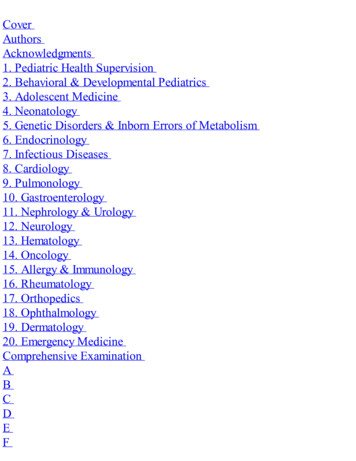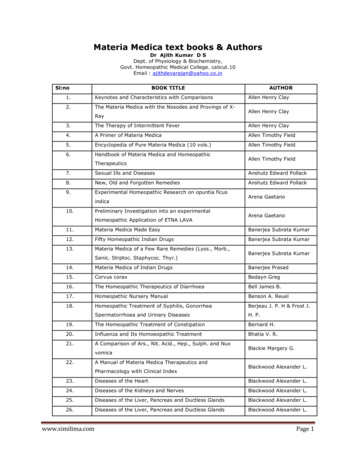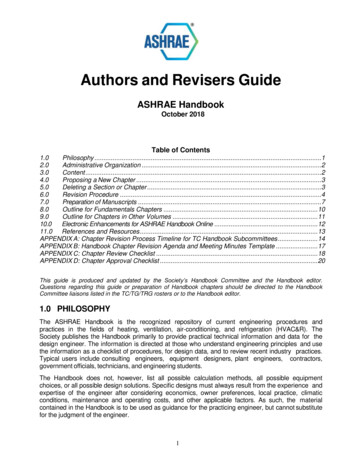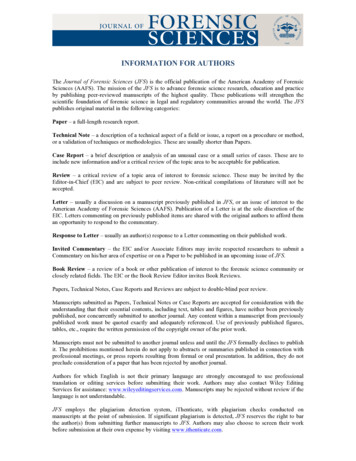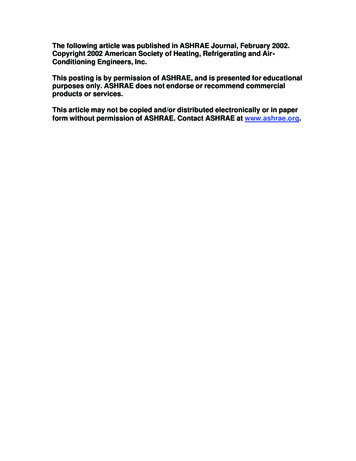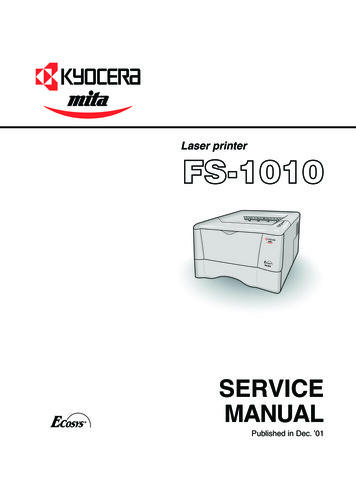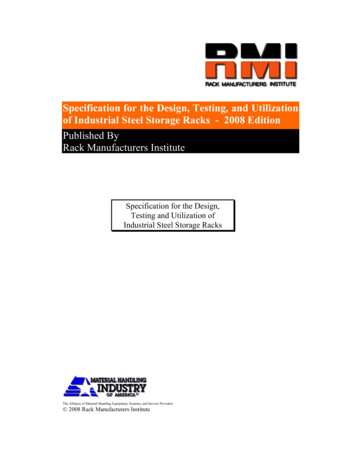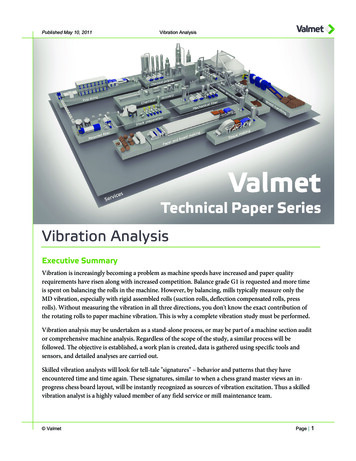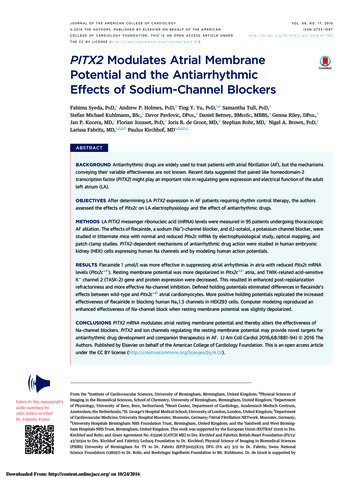
Transcription
JOURNAL OF THE AMERICAN COLLEGE OF CARDIOLOGYVOL. 68, NO. 17, 2016ª 2016 THE AUTHORS. PUBLISHED BY ELSEVIER ON BEHALF OF THE AMERICANCOLLEGE OF CARDIOLOGY FOUNDATION. THIS IS AN OPEN ACCESS ARTICLE UNDERISSN 766THE CC BY LICENSE 2 Modulates Atrial MembranePotential and the AntiarrhythmicEffects of Sodium-Channel BlockersFahima Syeda, PHD,a Andrew P. Holmes, PHD,a Ting Y. Yu, PHD,a,b Samantha Tull, PHD,aStefan Michael Kuhlmann, BSC,a Davor Pavlovic, DPHIL,a Daniel Betney, BMEDSC, MBBS,a Genna Riley, DPHIL,aJan P. Kucera, MD,c Florian Jousset, PHD,c Joris R. de Groot, MD,d Stephan Rohr, MD,c Nigel A. Brown, PHD,eLarissa Fabritz, MD,a,f,g,h Paulus Kirchhof, MDa,f,g,h,iABSTRACTBACKGROUND Antiarrhythmic drugs are widely used to treat patients with atrial fibrillation (AF), but the mechanismsconveying their variable effectiveness are not known. Recent data suggested that paired like homeodomain-2transcription factor (PITX2) might play an important role in regulating gene expression and electrical function of the adultleft atrium (LA).OBJECTIVES After determining LA PITX2 expression in AF patients requiring rhythm control therapy, the authorsassessed the effects of Pitx2c on LA electrophysiology and the effect of antiarrhythmic drugs.METHODS LA PITX2 messenger ribonucleic acid (mRNA) levels were measured in 95 patients undergoing thoracoscopicAF ablation. The effects of flecainide, a sodium (Na )-channel blocker, and d,l-sotalol, a potassium channel blocker, werestudied in littermate mice with normal and reduced Pitx2c mRNA by electrophysiological study, optical mapping, andpatch clamp studies. PITX2-dependent mechanisms of antiarrhythmic drug action were studied in human embryonickidney (HEK) cells expressing human Na channels and by modeling human action potentials.RESULTS Flecainide 1 mmol/l was more effective in suppressing atrial arrhythmias in atria with reduced Pitx2c mRNAlevels (Pitx2cþ/–). Resting membrane potential was more depolarized in Pitx2cþ/– atria, and TWIK-related acid-sensitiveKþ channel 2 (TASK-2) gene and protein expression were decreased. This resulted in enhanced post-repolarizationrefractoriness and more effective Na-channel inhibition. Defined holding potentials eliminated differences in flecainide’seffects between wild-type and Pitx2cþ/– atrial cardiomyocytes. More positive holding potentials replicated the increasedeffectiveness of flecainide in blocking human Nav1.5 channels in HEK293 cells. Computer modeling reproduced anenhanced effectiveness of Na-channel block when resting membrane potential was slightly depolarized.CONCLUSIONS PITX2 mRNA modulates atrial resting membrane potential and thereby alters the effectiveness ofNa-channel blockers. PITX2 and ion channels regulating the resting membrane potential may provide novel targets forantiarrhythmic drug development and companion therapeutics in AF. (J Am Coll Cardiol 2016;68:1881–94) 2016 TheAuthors. Published by Elsevier on behalf of the American College of Cardiology Foundation. This is an open access articleunder the CC BY license (http://creativecommons.org/licenses/by/4.0/).From the aInstitute of Cardiovascular Sciences, University of Birmingham, Birmingham, United Kingdom; bPhysical Sciences ofListen to this manuscript’saudio summary byJACC Editor-in-ChiefDr. Valentin Fuster.Imaging in the Biomedical Sciences, School of Chemistry, University of Birmingham, Birmingham, United Kingdom; cDepartmentof Physiology, University of Bern, Bern, Switzerland; dHeart Center, Department of Cardiology, Academisch Medisch Centrum,Amsterdam, the Netherlands; eSt. George’s Hospital Medical School, University of London, London, United Kingdom; fDepartmentof Cardiovascular Medicine, University Hospital Muenster, Muenster, Germany; gAtrial Fibrillation NETwork, Muenster, Germany;hUniversity Hospitals Birmingham NHS Foundation Trust, Birmingham, United Kingdom; and the iSandwell and West Birming-ham Hospitals NHS Trust, Birmingham, United Kingdom. This work was supported by the European Union (EUTRAF 25105 to Drs.Kirchhof and Rohr; and Grant Agreement No. 633196 [CATCH ME] to Drs. Kirchhof and Fabritz); British Heart Foundation (FS/13/43/30324 to Drs. Kirchhof and Fabritz); Leducq Foundation to Dr. Kirchhof; Physical Science of Imaging in Biomedical Sciences(PSIBS) University of Birmingham for TY to Dr. Fabritz (EP/F50053X/1); DFG (FA 413 3/1) to Dr. Fabritz; Swiss NationalScience Foundation (138297) to Dr. Rohr; and Boehringer Ingelheim Foundation to Mr. Kuhlmann. Dr. de Groot is supported byDownloaded From: http://content.onlinejacc.org/ on 10/24/2016
1882Syeda et al.JACC VOL. 68, NO. 17, 2016PITX2 Deficiency Potentiates Flecainide’s Antiarrhythmic EffectsABBREVIATIONSAND ACRONYMSAAD antiarrhythmic drugAPD action potentialAOCTOBER 25, 2016:1881–94trial fibrillation (AF) causes cardio-institutional review board of Academic Medical Cen-vascular death, frequent hospitali-ter, Amsterdam, the Netherlands. All patients pro-zation, and cognitive decline evenvided written informed consent.in patients treated according to guidelinesLeft atrial appendages (LAAs) were excised from 95(1–3). Antiarrhythmic drug (AAD) therapy re-patientsmains the most commonly used treatment toablation either in the AFACT (Atrial Fibrillationmaintain sinus rhythm in AF patients, butAblation and Autonomic Modulation via Thoraco-AAD effectiveness remains limited (3). Un-scopic Surgery) trial (12) or undergoing similar pro-kidneyfortunately, we lack a basic understandingcedures in the same centers using an endoscopicLA left atriumof why AADs prevent AF over long periodsstapling device, snap frozen in liquid nitrogen andLAA left atrial appendagein some patients but not in others (4,5). Iden-stored at –80 C (13). Deoxyribonucleic acid anddurationERP effective refractoryperiodHEK human embryonicundergoingbilateralthoracoscopicAFtifying factors that modify the effects ofribonucleicacidAADs would allow the selection of respon-and RNeasy kits (Qiagen Ltd., Manchester, UnitedNa sodiumsive patients and could help guide develop-Kingdom), respectively. PITX2 mRNA content wasPITX2 paired likement of novel AADs (6).quantified by quantitative polymerase chain reaction.mRNA messenger ribonucleichomeodomain-2Paired like homeodomain-2 transcriptionacidwereextractedusingDNeasySingle nucleotide polymorphisms (SNPs) rs2200733,PRR post-repolarizationfactor (PITX2) is a transcription factor thatrs6838973, and rs1448818 (14) were identified usingrefractorinessregulates the development of the left atriumTaqMan assays (Thermo Fisher Scientific Inc., Wal-RMP resting membrane(LA) and thoracic organs. Its c isoform istham, Massachusetts).potentialSNP single nucleotidepolymorphismTASK-2 TWIK-relatedacid-sensitive KD channelexpressed in the adult LA and regulates theAdult mice (age 12 to 16 weeks) on an MF1 back-expression of LA ion channels (7–9). Lowground with normal or reduced (Pitx2c þ/ ) atrialatrial Pitx2 expression renders mice suscep-Pitx2c expression were studied (8).tible to AF and shortens the LA action poten-LA epicardial monophasic action potentials weretial (8,10,11). In this study, we investigatedrecorded from Langendorff-perfused murine heartshow atrial PITX2 modifies the effects of AADs.SEE PAGE 1895(8,15). Programmed stimulation was performed atbaseline and with flecainide 1 m mol/l or d,l-sotalol10 m mol/l. Arrhythmia inducibility and effective re-We detected variable LA PITX2 messenger ribonu-fractory period (ERP) were measured by using singlecleic acid (mRNA) expression in AF patients requiringright atrial extrastimuli after steady-state pacing inrhythm control therapy. After finding that low Pitx2c1-ms decrements (15–18). Transmembrane actionenhanced the effect of flecainide, mediated by a morepotentials were recorded using borosilicate glasspositive resting membrane potential (RMP), wemicroelectrodes from superfused murine LAs (17),identified reduced TWIK-related acid-sensitive K þRMP, action potential duration (APD), upstroke ve-channel 2 (TASK-2) expression as a possible driver oflocity, and activation times were analyzed (15,17,18).this effect and replicated these effects in cellsThe human atrial cell model of Courtemanche et al.expressing human sodium (Na) channels and in a(19) was used. Pitx2c þ/– deficiency was modeled byhuman atrial action potential model.reducing IK1 conductance by 25% and doubling I Krconductance. Simulations were run in strands of 100METHODSatrial cells (cell length 100 m m). The 5 leftmost cells ofthe strand were paced (S1) for 2 min at 1,000- andAll experiments were conducted under the Animals500-ms basic cycle lengths. Premature stimulation(Scientific Procedures) Act 1986, and approved by the(S2) was applied to determine the ERP and conduc-home office (PPL number 30/2967) and the institu-tion velocity as measured from cells 25 to 75. Valuestional review board at the University of Birmingham.for all other parameters were measured from theAnalyses of human atrial tissue were approved by the50th cell. For the modeling, post-repolarizationNWO/ZonMW VIDI Grant 016.146.310. Dr. Riley is currently employed by Bio-Techne (R&D Products). Dr. Fabritz has receivedfurther institutional research grant support from DFG, MRC, and Gilead Inc. Dr. Kirchhof has received further research supportfrom the German Centre for Heart Research and from several drug and device companies active in atrial fibrillation; and hasreceived honoraria from several such companies. Drs. Syeda, Fabritz, and Kirchhof are listed as inventors on a patent(WO2015/140571) held by the University of Birmingham on genotype-specific antiarrhythmic drug therapy of atrial fibrillation.All other authors have reported that they have no relationships relevant to the contents of this paper to disclose. Drs. Syedaand Holmes contributed equally to this work.Manuscript received February 11, 2016; revised manuscript received July 5, 2016, accepted July 20, 2016.Downloaded From: http://content.onlinejacc.org/ on 10/24/2016
Syeda et al.JACC VOL. 68, NO. 17, 2016PITX2 Deficiency Potentiates Flecainide’s Antiarrhythmic EffectsOCTOBER 25, 2016:1881–94refractoriness (PRR) was calculated as the differencebetween APD at –60 mV repolarization and ERP.LA cell isolation was performed as previously reported (20). Standard I Na and I K1 currents wererecorded as previously published (18–20). Background K þ (TASK-like) currents sensitive to high Ba2þT A B L E 1 Baseline Characteristics (N¼ 101)*59.7 8.4 (40–76)Age, yrsMale79Congestive heart failure6Hypertension34Age 75 yrs1(10 mM) were measured (21–23). Human embryonicDiabetes9kidney (HEK) 293 cells stably expressing the humanStroke/transient ischemic attack/embolus10Nav 1.5 channel were obtained (SB Ion Channels,Vascular disease10Glasgow, UK).Female22Age 65 eic acid were synthesized from murine LA,CHA2DS2-VASc score060(SuperScript VILO, Thermo Fisher Scientific Inc.) to124quantify expression of 20 atrial ion channels and 217genes with suspected PITX2-dependent regulation (9)Previous catheter ablation for AFusing custom-designed Taqman low density arrayType of oblotting was performed on murine LA tissuelysates with antibodies detecting TASK-2, Kv 1.6, mal44Persistent56Longstanding persistent1AF duration, yrs6.0 (1–35)Antiarrhythmic drugs and rate control agentsexchanger 1, Serca2a, Na v1.5, or calnexin, usingQuinidine or disopyramide4standard methods.Flecainide or propafenone33Optical action potentials and calcium ion (Ca 2þ)Amiodarone, dronedarone, or sotalol41transients were recorded in murine LA and analyzedBeta blockers53using custom-made MATLAB algorithms (MathWorks,Verapamil or diltiazem17Digoxin15Natick, Massachusetts) as previously described (17).Anticoagulant agents (before PVI procedure)STATISTICAL ANALYSIS. All experiments were per-Vitamin K antagonistsformed and analyzed in a blinded fashion. MurineAntiplateletsstudies were performed and analyzed blinded to genotype in littermate pairs. Categorical data werecompared using the Fisher exact test. Numerical data896Values are mean SD (range), n, or mean (range). *Left atrial appendages werecollected from these patients with atrial fibrillation (AF).PVI ¼ pulmonary vein isolation.were compared by 2-sided paired parametric Studentt tests (e.g., measurements before and after perfusionof flecainide or sotalol) and Wilcoxon signed rankarrhythmias in hearts with reduced Pitx2c expressiontests. Multiple measurements were assessed by(0 of 17 hearts with atrial arrhythmias) but not inrepeated measures of analysis of variance followed byhearts with normal Pitx2c expression (atrial arrhyth-correction for multiple comparison (Bonferroni test)mias remained in 3 of 12 hearts) (Figures 1A to 1C).if the overall test was significant. Two-sided p 0.05were considered significant. Box plots depict individual measurements (points), mean, and SEM. Statistics and figures were created using Prism 5(GraphPad Software, San Diego, California).RESULTSPITX2 mRNA varied markedly in human LAA (CentralIllustration) harvested from AF patients (Table 1) (13),T A B L E 2 PITX2 mRNA Expression in Left Atrial Appendages FromAF Ablation Patients*RiskAlleles25% IQRMedian75% IQRMeanSEMNo. 004.295.414.390.510suggesting that a 50% lowered PITX2 expression de-51.962.664.663.100.74fines a large, potentially clinically relevant group of64.954.954.954.950.01AF patients. This did not directly correlate with SNPhaplotype (Table 2), although we found numericallylower PITX2c levels in patients with 5 risk alleles.Flecainide suppressed atrial arrhythmias in murinePitx2cþ/– hearts. Flecainide abolished induced atrialDownloaded From: http://content.onlinejacc.org/ on 10/24/2016*This dataset was grouped according to the number of risk single nucleotide polymorphism (SNP)alleles for AF on chromosome 4q25 (rs2200733, SNP2 rs6838973, rs1448818 [13]). AlthoughPITX2 mRNA is numerically lower in patients with 5 or 6 risk alleles, we did not find a PITX2 mRNAgradient according to AF risk.IQR ¼ interquartile range; LA ¼ left atrium; other abbreviations as in Table 1.1883
1884Syeda et al.JACC VOL. 68, NO. 17, 2016PITX2 Deficiency Potentiates Flecainide’s Antiarrhythmic EffectsOCTOBER 25, 2016:1881–94F I G U R E 1 Atrial Arrhythmia Inducibility in Pitx2c þ/– Murine Whole HeartsBAtrial arrhythmia inducibilityPitx2c /–WT201510515105Atrial arrhythmia inducibilityS2S2S2ecaincainNo arrhythmiasCide0FleBaseline0*linLVRV20BaseRA25No. of HeartsNo. of HeartsLA25FleMAP electrodeMouse EPcatheterideAArrhythmiasS2LA MAPEGEGFlecainide (1µmol/L)BaselineΔERP Inducedby Flecainide (ms)D30WTPitx2c /–2010*0–10–20n 10–1380100120Paced Cycle Length (ms)EFlecainideBaselineWTPitx2c /–Pitx2c /–WTAPD90ERP baselineERP flecainide#* #10ms(A) Image and schematic representation of the Langendorff-perfused heart. (B) Atrial arrhythmia inducibility in isolated, beating hearts fromwild-type (WT) and reduced paired like homeodomain 2 messenger ribonucleic acid (Pitx2cþ/–) mice. Flecainide abolished atrial arrhythmiainducibility in Pitx2cþ/– hearts only. *p 0.05 flecainide versus baseline. (C) Representative trace of atrial fibrillation (AF) induced duringprogrammed stimulation at baseline, showing reduced severity of arrhythmias with 1 mmol/l flecainide in Pitx2cþ/– atria. (D) Effects of flecainideon atrial effective refractory period (ERP) in wild-type and Pitx2cþ/– isolated, beating hearts. Shown is the difference in atrial ERP betweenbaseline and 1 mmol/l flecainide at 80- to 120-ms paced cycle length following a single extrastimulus (S2) in WT and Pitx2cþ/– isolated, beatinghearts. *p 0.05 between genotypes across all cycle lengths. (E) Whereas flecainide prolonged ERP in both genotypes, this effect was morepronounced in Pitx2cþ/– atria. Flecainide caused post-repolarization refractoriness (PRR), the difference between ERP (orange and grey lines)and APD90 (blue lines), in WT and Pitx2cþ/– atria. Flecainide-induced PRR in Pitx2cþ/– is almost 3 times that of WT atria. *p 0.05 WTversus Pitx2cþ/–. #p 0.05 baseline versus 1 mmol/l flecainide. APD ¼ action potential duration; EG ¼ intracardiac electrogram; EP ¼electrophysiology; LA ¼ left atrium; LV ¼ left ventricle; MAP ¼ monophasic action potential; RA ¼ right atrium; RV ¼ right ventricle.Downloaded From: http://content.onlinejacc.org/ on 10/24/2016
FlecainideBaseline23.5 2.3 (11)29.8 3.0 (11)22.2 2.1 ecainideBaseline80FlecainideBaselineFlecainideLA ERP, ms29.6 3.3 (11)21.9 2.4 (10) 28.7 3.5* (10) 30.5 2.4 (11)38.5 3.3* (11) 28.0 2.3 (13) 40.2 2.8* (13) 27.5 2.5 (13)41.2 3.0*† (13)10.3 1.0 (11)LA monophasic APD, msAPD5010.2 1.3 (8)14.5 1.7 (8)10.8 1 (8)11.9 1.6 (8)10.4 0.7 (7)12.0 1.1 (7)12.4 1.1 (15)14.4 1.3 (15)11.5 1.0 (15)12.4 1.1 (15)10.6 0.9 (11)APD7017.8 2.2 (9)23 2.1 (9)18.4 1.6 (9)18.7 2.2 (9)18.1 1.2 (8)18.1 1.9 (8)18.0 1.6 (15)19.2 1.8 (15)16.0 1.4 (13)16.2 1.4 (13)14.9 1.0† (10)13.1 0.7 (10)APD9031.3 3.0 (8)37.4 2.8 (8)31.5 2.5 (9)29.9 2.9 (9)31.0 1.4 (8)28.4 2.7 (8)26.8 1.7 (10)23.1 1.4 (10)28.3 2.2 (13) 29.9 2.2 (13)27.4 2.2 (13) 26.6 1.5 (13)Syeda et al.100BaselinePITX2 Deficiency Potentiates Flecainide’s Antiarrhythmic Effects120Paced CL, msJACC VOL. 68, NO. 17, 2016Pitx2cþ/–Wild-TypeOCTOBER 25, 2016:1881–94T A B L E 3 Effect of Flecainide on Refractoriness and Repolarization in Mouse HeartsLA transmembrane APD, msAPD304.5 0.1 (30)5.5 0.3 (22)4.5 0.1 (30)5.4 0.3 (22)4.4 0.1 (30)5.2 0.3 (22)4.0 0.1 (31)4.7 0.2 (24)3.9 0.1 (31)4.6 0.2 (24)3.8 0.1† (31)APD506.7 0.2 (30)8.2 0.5 (22)6.6 0.2 (30)8.0 0.4 (22)6.4 0.2 (30)7.8 0.5 (22)5.9 0.2 (31)7.1 0.4 (24)5.7 0.2 (31)7.0 0.4 (24)5.6 0.2† (31)6.7 0.3 (24)8.6 0.4 (31) 10.3 0.6 (24)8.3 0.3† (31)9.8 0.5 (24)APD7010.5 0.4 (30) 12.7 0.8 (22) 10.1 0.4 (30) 12.1 0.7 (22)9.6 0.4 (30) 11.8 0.7 (22)APD9020.9 1.0 (30) 23.4 1.5 (22) 19.9 0.9 (30) 22.2 1.4 (22) 18.4 0.8 (30) 21.6 1.3 (22)8.9 0.4 (31) 10.7 0.6 (24)17.6 0.9 (31) 20.3 1.1 (24)16.5 0.8 (31) 19.2 1.0 (24)4.4 0.2 (24)15.7 0.8† (31) 17.9 0.9 (24)LA optical APD, msAPD306.1 0.3 (10)6.4 0.8 (10)5.9 1.0 (6)6.1 0.4 (10)7.7 0.9 (8)4.6 0.3 (10)5.4 0.7 (8)4.3 0.4† (10)APD508.5 0.6 (10) 10.7 1.2 (6)7.3 0.6 (6)8.9 1.1 (10)8.5 1.2 (6)8.3 0.7 (10) 10.3 1.8 (6)6.9 0.4 (10) 10.0 1.0 (8)6.6 0.4 (10)8.1 0.9 (8)6.1 0.4† (10) 8.0 0.9 (8)APD7011.7 1.2 (10)12.5 1.5 (10)12.8 1.7 (6)11.5 1.1 (10)9.4 0.0 (10) 13.3 1.2 (8)9.4 0.6 (10) 11.6 1.5 (8)15.0 2.1 (6)6.9 1.3 (6)14.4 2.5 (6)4.9 0.4 (10)5.7 0.7 (8)9.1 0.5† (10) 11.2 1.2 (8)Values are mean SEM (number of atria). *p 0.05 vs. baseline. †p 0.05 vs. wild-type.APD ¼ action potential duration; CL ¼ cycle length; ERP ¼ effective refractory period; Pitx2cþ/– ¼ PITX2 deficient; other abbreviations as in Tables 1 and 2.T A B L E 4 Electrophysiological Effects of SotalolPitx2cþ/–Wild-Type120Paced CL, otalolBaselineSotalol38.7 7.8 (7)33.9 6.3 (7)32.2 6.1 (6)29.2 5.3 (6)39.3 4.0 (4)26.8 3.5 (4)37.0 5.7 (4)24.0 3.7 (4)LA ERP, msLA APD, msAPD5011.5 1.2 (9)13.4 1.2 (9)10.9 2.0 (7)12.2 1.3 (7)10.8 1.1 (7)11.2 1.0 (7)APD7017.6 2.2 (9)20.0 1.9 (9)16.0 1.3 (7)18.2 2.3 (7)16.5 1.6 (7)17.3 1.2 (7)13.0 1.5 (4)17.0 1.9 (4)APD9030.7 3.2 (9)33.5 2.7 (9)29.0 1.9 (7)30.9 3.2 (7)29.7 2.7 (7)31.2 2.0 (7)23.8 2.8 (4)29.6 2.9 (4)Values are mean SEM (number of atria).Abbreviations as
institutional review board of Academic Medical Cen-ter, Amsterdam, the Netherlands. All patients pro-vided written informed consent. Left atrial appendages (LAAs) were excised from 95 patients undergoing bilateral thoracoscopic AF ablation either in the AFACT (Atrial Fi
